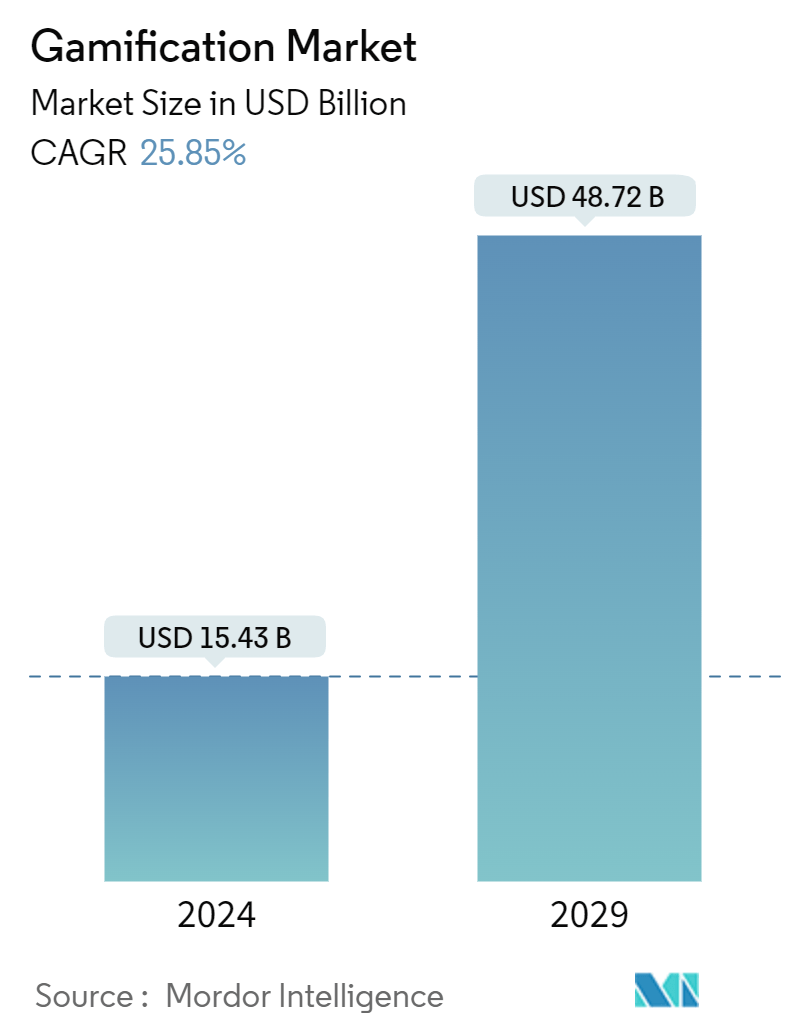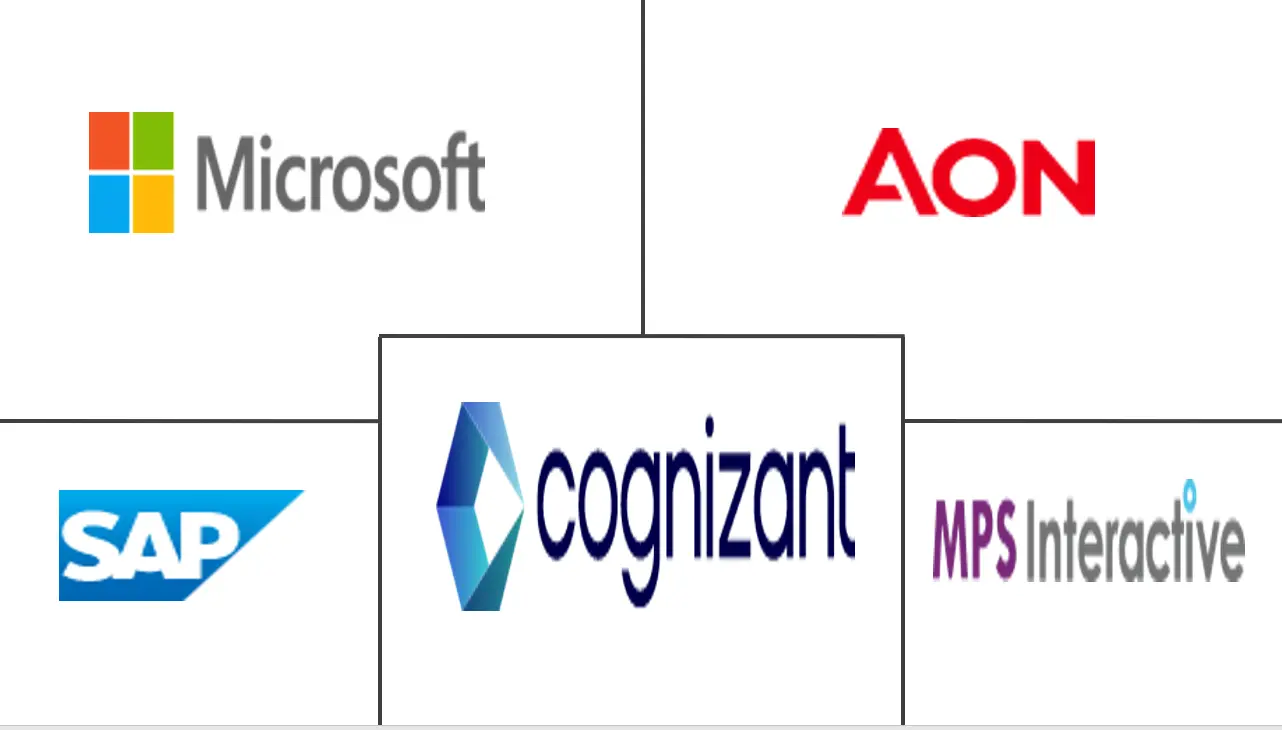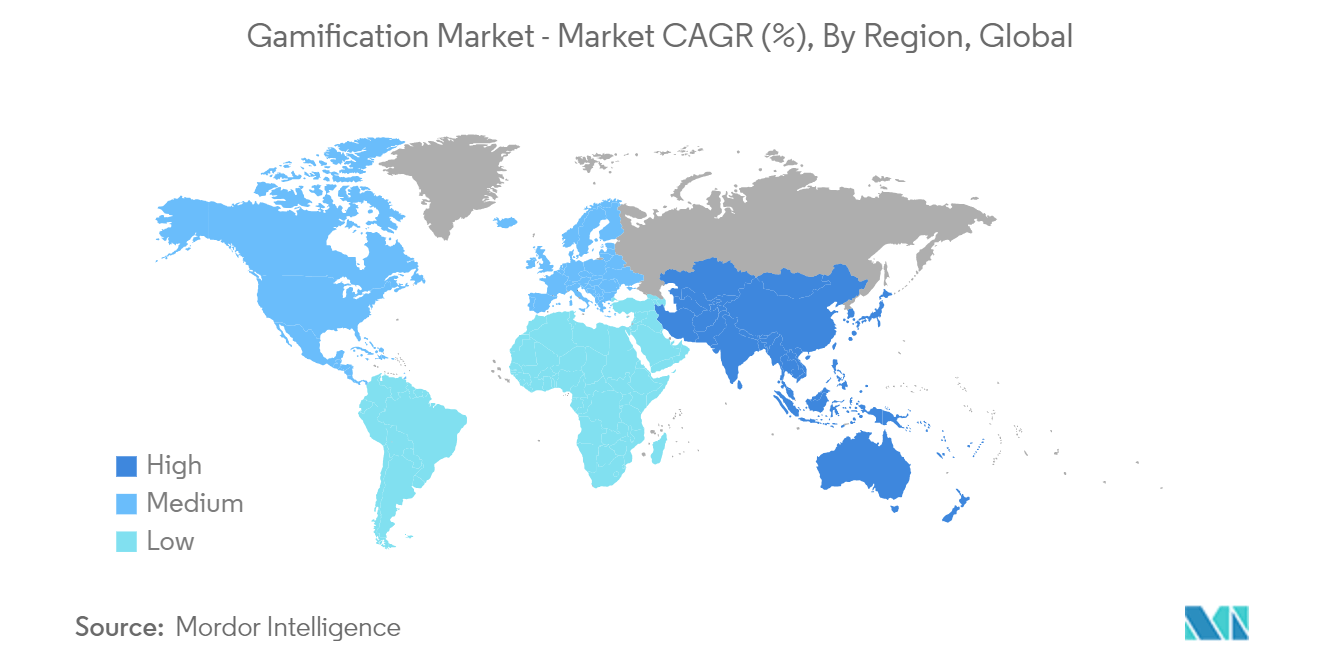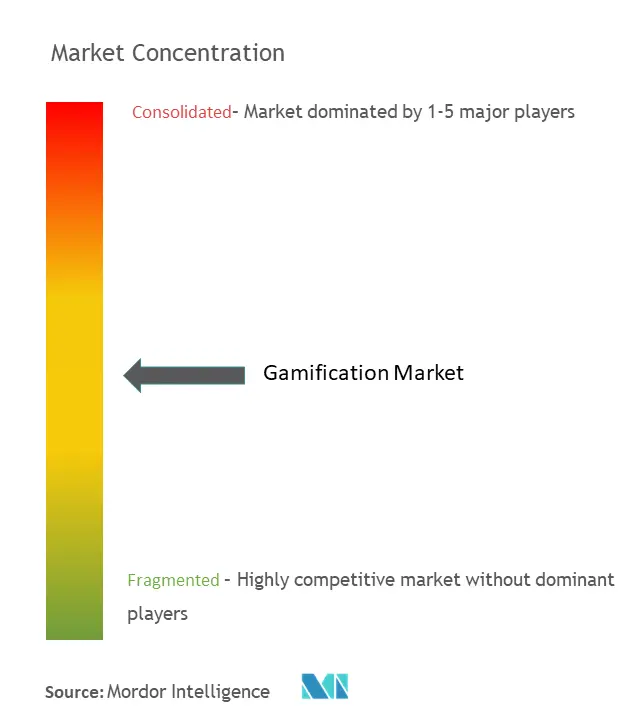Gamification Market Size

| Study Period | 2019 - 2029 |
| Market Size (2024) | USD 15.43 Billion |
| Market Size (2029) | USD 48.72 Billion |
| CAGR (2024 - 2029) | 25.85 % |
| Fastest Growing Market | Asia Pacific |
| Largest Market | North America |
| Market Concentration | Medium |
Major Players
*Disclaimer: Major Players sorted in no particular order |
Gamification Market Analysis
The Gamification Market size is estimated at USD 15.43 billion in 2024, and is expected to reach USD 48.72 billion by 2029, growing at a CAGR of 25.85% during the forecast period (2024-2029).
The surge in smartphones and mobile devices has significantly bolstered the gamification market. As businesses increasingly recognize gamification's potential, they are leveraging it to shape human behavior, driving innovation, productivity, and engagement. The widespread adoption of mobile technology has created a fertile ground for gamification strategies to thrive, offering new avenues for businesses to connect with their audiences in more interactive and engaging ways.
- This growth is further supported by the increasing sophistication of mobile devices, which now offer advanced features such as augmented reality (AR) and virtual reality (VR), enhancing the gamification experience.
- Moreover, users can now share their experiences by integrating with social networks, amplifying the platform's impact. Social media integration allows gamified applications to reach a broader audience as users share their achievements and progress with their networks, creating a viral effect.
- Marketers, leveraging mobile apps, can conduct surveys, even single-question ones, gathering valuable insights from their target audience. This real-time feedback mechanism enables businesses to tailor their marketing strategies more effectively, ensuring they meet the evolving needs and preferences of their customers.
- Recent research from MIT highlights that agile organizations not only witness accelerated revenue growth but also enjoy a 30% higher profitability compared to their non-agile counterparts. This underscores the importance of adopting flexible and responsive business practices in conjunction with gamification strategies to achieve optimal results. Furthermore, the ability to collect and analyze data from gamified interactions provides businesses with deeper insights into consumer behavior, allowing for more targeted and effective marketing campaigns.
- While businesses are increasingly adopting gamification, many are doing so in a rather generic manner, relying heavily on point systems, leaderboards, and badges. This approach, lacking a nuanced balance between competition and collaboration, risks undermining the method's potential, with an estimated 80% of efforts falling short of expectations.
- Looking ahead, the integration of advanced technologies like AI and ML is poised to surge. Enterprises and vendors are refining solutions that not only learn but also evolve to be more intuitive and efficient over time. AI and ML technologies can enhance gamification by providing personalized experiences, predicting user behavior, and adapting content to keep users engaged.
- Consequently, investments in these technologies are projected to rise in the near future as businesses seek to leverage their potential to create more sophisticated and effective gamification strategies.
Gamification Market Trends
Retail Segment Holds Largest Market Share
- The retail sector is experiencing substantial growth, with sales increasing steadily in recent years. Customers, increasingly focused on projecting their personal brand on social media, are driving this trend by seeking tailored experiences and products.
- Integrating gamification into a retailer's marketing strategy not only adds entertainment but also cultivates positive behaviors among both customers and employees. This, in turn, leads to a more immersive brand experience and, ultimately, higher sales.
- According to an HBR article, gamification is a potent tool for enhancing customer retention. It is reported to boost retention rates by 5%, elevate profits by 25% to 95%, and generally yield superior business outcomes. For instance, brands are leveraging scannable codes on products, rewarding customers with loyalty points upon scanning. From enhancing discovery and engagement to fostering brand advocacy and loyalty, retailers are increasingly weaving gamification into the fabric of the customer shopping journey.
- Retail gamification, a burgeoning trend in e-commerce, is witnessing rapid adoption. Online retailers are doubling down on interactive experiences to drive sales, with gamification apps proving their mettle in boosting leads and conversions. Moreover, gamification is not just about attracting new customers; it is also a powerful tool for retaining them.
- Retailers are increasingly adopting innovative gamification strategies to enhance consumer engagement, build brand loyalty, and improve the retail experience. Gen Z is leading this trend, with 77% participating in daily mobile gaming, according to Tapjoy. From February 2023 to 2024, global female mobile gamers spent an average of 22 minutes daily on casual games, surpassing their male counterparts, who averaged 20.6 minutes. Notably, male gamers in North America showed the least interest in this category. Consequently, retailers, particularly in the grocery sector, are recognizing the importance of tailoring their strategies to effectively engage this influential demographic.
- Retailers and brands can extract even more value from gamification by offering users progress charts. These charts can highlight key metrics, such as past purchases, friend referrals, and updates on new product categories. By striking a balance between 'wins' and 'rewards,' retailers can engage their audience and drive tangible commercial benefits, ensuring customers keep coming back for more.

North America Anticipated to Hold Largest Market Share
- The North American marketing sector boasts a mature gamification market. This trend extends beyond marketing, increasingly being leveraged for product development and innovation on a regional scale. With a significant portion of the population utilizing smartphones and the internet, North America has experienced a surge in gamification adoption, particularly through the integration of social media tools.
- Prominent companies, including consumer brands such as Adobe, NBC, Walgreens, eBay, Panera, and Threadless, have initiated substantial gamification projects since the industry's inception. In addition, B2B enterprises like Oracle, Cisco, and Salesforce have incorporated gamification into their regional enterprise strategies, recognizing its critical role in consumerization.
- These organizations are particularly attracted to gamification's ability to enhance engagement and loyalty, with an average increase of 30% over time, driven by repeat visits and viral diffusion. Beyond engagement, the financial benefits of gamification are noteworthy. For example, Autodesk, an American multinational software company, reported a 40% increase in trial usage and a 15% rise in conversion rates, while Extraco Bank achieved a remarkable 700% increase in client acquisitions. Furthermore, global corporations are expanding their presence in the North American market to address the growing demand for gamification solutions.

Gamification Industry Overview
The gamification market features moderate competition, with a few key players leading. These dominant players actively broaden their reach into international markets, employing strategic collaborations to bolster their market share and profitability. By leveraging these collaborative initiatives, they aim to enhance their competitive positioning and drive sustained growth in the global market.
For instance, in July 2024, Xplor Mariana Tek, a prominent boutique fitness software platform under Xplor Technologies, unveiled a suite of gamification tools designed to enhance engagement among fitness studio members. The platform's latest features aim to strengthen community building and improve member retention by incorporating elements of competition and achievement into the studio experience.
Gamification Market Leaders
-
Cognizant Technology Solution Corp.
-
MPS Interactive Systems Limited
-
Microsoft Corporation
-
SAP SE
-
Aon plc
*Disclaimer: Major Players sorted in no particular order

Gamification Market News
- June 2024: At the Aircraft Interiors Expo 2024 (AIX2024), FlightPath3D, a provider of inflight entertainment solutions, launched an upgraded version of its acclaimed Kids Map.
- March 2024: Mindgruve, a prominent digital marketing agency, and Kick It California, the longest-standing statewide phone-based tobacco cessation initiative in the United States, collaborated to introduce a gamified app. This app is designed to assist Californians in their efforts to quit smoking and vaping. Going beyond conventional cessation methods, it offers users a personalized journey, providing a comprehensive tool to address their tobacco and nicotine dependencies effectively.
- March 2024: Chime, a prominent digital bank, partnered with Zogo, a financial education platform, to introduce gamified financial education on its mobile app. In April 2024, Chime rebranded Financial Literacy Month as Financial Progress Month, underscoring its commitment to enhancing financial education for its members. This collaboration marks a notable stride in equipping the next generation with crucial financial literacy tools.
Gamification Market Report - Table of Contents
1. INTRODUCTION
1.1 Study Assumptions and Market Definition
1.2 Scope of the Study
2. RESEARCH METHODOLOGY
3. EXECUTIVE SUMMARY
4. MARKET INSIGHTS
4.1 Market Overview
4.2 Industry Attractiveness - Porter's Five Forces Analysis
4.2.1 Bargaining Power of Buyers/Consumers
4.2.2 Bargaining Power of Suppliers
4.2.3 Threat of New Entrants
4.2.4 Threat of Substitute Products
4.2.5 Intensity of Competitive Rivalry
4.3 Assessment of COVID-19 Impact on the Market
5. MARKET DYNAMICS
5.1 Market Drivers
5.1.1 Mobile-based Gamification Gaining Momentum
5.1.2 Crowdsourcing Seen as a Major Opportunity in Innovation and Development
5.2 Market Restraints
5.2.1 Manufacturing Complications and Lower ROI
6. MARKET SEGMENTATION
6.1 By Deployment
6.1.1 On-premise
6.1.2 On-cloud
6.2 By Size
6.2.1 Small and Medium Enterprises
6.2.2 Large Enterprises
6.3 By Platform
6.3.1 Open Platform
6.3.2 Closed/ Enterprise Platform
6.4 By End-user Vertical
6.4.1 Retail
6.4.2 Banking
6.4.3 Government
6.4.4 Healthcare
6.4.5 Education and Research
6.4.6 IT and Telecom
6.4.7 Other End-user Verticals
6.5 By Geography**
6.5.1 North America
6.5.2 Europe
6.5.3 Asia-Pacific
6.5.4 Latin America
6.5.5 Middle East and Africa
7. COMPETITIVE LANDSCAPE
7.1 Company Profiles
7.1.1 Cognizant Technology Solution Corp.
7.1.2 MPS Interactive Systems Limited
7.1.3 Microsoft Corporation
7.1.4 SAP SE
7.1.5 Aon PLC
7.1.6 Axonify Inc.
7.1.7 IActionable Inc.
7.1.8 Bunchball Inc.
7.1.9 Ambition
7.1.10 G-Cube
- *List Not Exhaustive
8. INVESTMENT ANALYSIS
9. MARKET OPPORTUNITIES AND FUTURE TRENDS
Gamification Industry Segmentation
Gamification uses the human tendency to influence one's thinking process by engaging users to become effective problem solvers, even in the real world. The study aims to analyze and understand the gamification market's current growth, opportunities, and challenges.
The scope of market analysis is segmented by deployment (on-premise and on-cloud), size (small and medium enterprises and large enterprises), platform (open platform and closed/enterprise platform), end-user vertical (retail, banking, government, healthcare, education and research, IT and telecom, and other end-user verticals), and geography (North America, Europe, Asia-Pacific, Latin America, and Middle East and Africa). The market sizes and forecasts are provided in USD for all the above segments.
| By Deployment | |
| On-premise | |
| On-cloud |
| By Size | |
| Small and Medium Enterprises | |
| Large Enterprises |
| By Platform | |
| Open Platform | |
| Closed/ Enterprise Platform |
| By End-user Vertical | |
| Retail | |
| Banking | |
| Government | |
| Healthcare | |
| Education and Research | |
| IT and Telecom | |
| Other End-user Verticals |
| By Geography** | |
| North America | |
| Europe | |
| Asia-Pacific | |
| Latin America | |
| Middle East and Africa |
Gamification Market Research Faqs
How big is the Gamification Market?
The Gamification Market size is expected to reach USD 15.43 billion in 2024 and grow at a CAGR of 25.85% to reach USD 48.72 billion by 2029.
What is the current Gamification Market size?
In 2024, the Gamification Market size is expected to reach USD 15.43 billion.
Who are the key players in Gamification Market?
Cognizant Technology Solution Corp., MPS Interactive Systems Limited, Microsoft Corporation, SAP SE and Aon plc are the major companies operating in the Gamification Market.
Which is the fastest growing region in Gamification Market?
Asia Pacific is estimated to grow at the highest CAGR over the forecast period (2024-2029).
Which region has the biggest share in Gamification Market?
In 2024, the North America accounts for the largest market share in Gamification Market.
What years does this Gamification Market cover, and what was the market size in 2023?
In 2023, the Gamification Market size was estimated at USD 11.44 billion. The report covers the Gamification Market historical market size for years: 2019, 2020, 2021, 2022 and 2023. The report also forecasts the Gamification Market size for years: 2024, 2025, 2026, 2027, 2028 and 2029.
How is Gamification being used in education?
In education, gamification is used to make learning more engaging and interactive, with elements like points, badges, and leaderboards to motivate students and track progress.
What are the latest trends in the Gamification Industry?
The Latest trends in the Gamification Industry include: a) Integration of Artificial Intelligence and machine learning for personalized experiences b) Use of Augmented Reality (AR)/ Virtual Reality (VR) for immersive experiences c) Focus on social gamification for community building
Gamification Industry Report
The Gamification Market is booming, fueled by the demand for engaging solutions in sectors like telecom and retail, aiming to enhance customer satisfaction and loyalty. This growth is powered by the adoption of gamification strategies, which are proving effective in boosting employee engagement and customer interaction through rewards and recognition. North America leads in adopting these solutions, with the integration of artificial intelligence (AI) technology paving the way for more personalized strategies. The services segment, offering consulting and implementation, is witnessing rapid growth, essential for tailoring gamification to specific business needs. As businesses recognize gamification's potential to drive engagement, productivity, and innovation, the future looks promising. This trend is supported by gamification statistics and trends, indicating a significant market expansion. For detailed insights, Mordor Intelligence™ provides a comprehensive analysis, including market share, size, and revenue growth rate, available as a free report PDF download.



